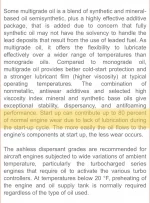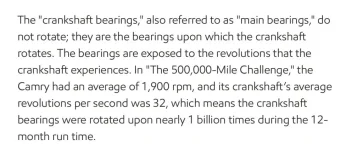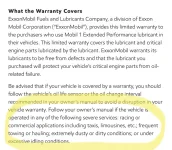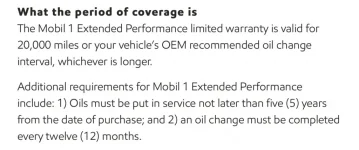You are using an out of date browser. It may not display this or other websites correctly.
You should upgrade or use an alternative browser.
You should upgrade or use an alternative browser.
Mobil1 High Mileage frustration...
- Thread starter wemay
- Start date
- Status
- Not open for further replies.
Yes that's what they say now, but a while back the website used to say seal swellers. Unless they have changed the compounds they use then it is just semantics.
This is one of the many old threads on this often discussed topic where at the time the word used was "sweller".
https://www.bobistheoilguy.com/forums/threads/mobil-1-high-mileage-in-a-car-with-low-miles.205666/
This is one of the many old threads on this often discussed topic where at the time the word used was "sweller".
https://www.bobistheoilguy.com/forums/threads/mobil-1-high-mileage-in-a-car-with-low-miles.205666/
@Bob Arnzen
The video is this one...
At 00:16 they begin to say that they performed one extreme test, using one motor oil. Where this image is used...
 .
.
Looks to be about M1HM to me. Without a doubt.
The video is this one...
At 00:16 they begin to say that they performed one extreme test, using one motor oil. Where this image is used...
Looks to be about M1HM to me. Without a doubt.
High Mileage oils are formulated to deal with high mileage elastomers that shrink with heat and time and wear.The bottle of HM says seal conditioner not swellers
They deal with it by increasing the "swell" of the elastomers slightly.
This "conditions" them to perform more like they did when they were brand-new.
Looks to be about M1HM to me.
At the teardown at 500,000 miles that seems to be a reasonable guess, although the video itself does not say that at that point they were using the oil in the background.
Now if we can find a similar picture with oil in the background when the 500,000 mile run began ....
- Joined
- Dec 30, 2006
- Messages
- 29,558
500K on an engine running on a stand in a lab is totally different from a 500K engine in a daily driver.
It shouldn’t be, if that’s the case then it’s a poorly designed test. One would hope the test stand routine would model typical driving habits.500K on an engine running on a stand in a lab is totally different from a 500K engine in a daily driver.
You know, something like this
- Joined
- Dec 30, 2006
- Messages
- 29,558
It shouldn’t be, if that’s the case then it’s a poorly designed test. One would hope the test stand routine would model typical driving habits.
You know, something like this
Man that's a trip!
It shouldn’t be, if that’s the case then it’s a poorly designed test. One would hope the test stand routine would model typical driving habits.
You know, something like this
That test rig is one seriously great piece of engineering. GM has one, too. I used to watch the LT4 V8 running on it back in 2014.
https://www.mobil.com/en/lubricants...ars/high-mileage-guide/high-mileage-challenge500K on an engine running on a stand in a lab is totally different from a 500K engine in a daily driver.

10,000 miles @ 65 mph is ~154 engine hours.
500,000 miles @ 65 mph is 7,692 engine hours.
The average person will average about 33 mph, or at least that is the number I have seen thrown around a lot. I have seen some companies use 25 mph as their number to determine maintenance schedules based around hours of operation instead of mileage (for stationary use vehicles and equipment).
Now, let’s assume 33 mph for the average driver:
A consumer passenger car accumulates 7,692 engine hours while averaging 33 mph over the life of their car. They have put as many engine hours on their car as Mobil put on their test car, but the consumer car only has 253,836 miles.
The Mobil 1 test car has received an oil change every 154 engine hours @ 10,000 mile intervals.
The Consumers car has also received an oil change every 10,000 miles, but has put on ~303 engine hours, almost double the engine hours of the test car. Also remember that the consumer car is started and stopped many times over an OCI.
Based on the numbers Mobil gives us, you could also call into question their 20,000 mile EP oils. Are they good for 20,000 miles at 65 mph (~308 engine hours) or 30 mph (~667 engine hours)? Their testing may indicate that the oil provides adequate protection for 300 hours (20k miles at 65 mph), but how does that translate to the real world conditions with idling in traffic, high RPM WOT runs merging into traffic and multiple daily starts and stops with many cold to hot thermal cycles ?
Running at 1,900 RPM in nearly constant hydrodynamic lubrication for 12 months isn’t what a car is going to experience in the real world. Remember that the are only a little over 8,700 hours in a year, the Mobil team put almost 7,700 engine hours on the test car in 12 months. This car was kept at operating temperature, which is easy on the oil and produces less wear and tear within the engine. Most engine wear occurs at startup. (Source)


Now for a real world, personal example:
My last vehicle was a 2007 Toyota Tacoma with the 4.0 V6.
10-20-2017: Oil and filter changed, 82,653 miles. Hour meter reset to zero.
4-26-2018: Oil and filter changed, 84,668 miles: 185 hours and 7 minutes of runtime since the last OCI.
I had driven 2,015 miles and accumulated 185 engine hours. My average speed for that OCI was 10.89 MPH.
If I had put that same number of hours on my engine under Mobil’s test conditions (@ 65 MPH), I would have traveled 12,025 miles.

Attachments
My 05 Silverado work truck has 200k miles and 8700 hours. That's 23mph average. Actually lower than I would expect for the amount of idling time it used to get from other drivers who didn't care. These trucks are known for the hours resetting for no reason so it's possible that had happened although it definitely hasn't in the time I've been around the truck regularly (the past 5 years).
That test is definitely not representative of 500k miles if it was 65mph even the majority of the time.
That test is definitely not representative of 500k miles if it was 65mph even the majority of the time.
Attachments
- Joined
- Dec 30, 2006
- Messages
- 29,558
This test is still in a controlled lab. MUCH different environment than a daily driver who even changes every 3K.https://www.mobil.com/en/lubricants...ars/high-mileage-guide/high-mileage-challenge
View attachment 26622
10,000 miles @ 65 mph is ~154 engine hours.
500,000 miles @ 65 mph is 7,692 engine hours.
The average person will average about 33 mph, or at least that is the number I have seen thrown around a lot. I have seen some companies use 25 mph as their number to determine maintenance schedules based around hours of operation instead of mileage (for stationary use vehicles and equipment).
Now, let’s assume 33 mph for the average driver:
A consumer passenger car accumulates 7,692 engine hours while averaging 33 mph over the life of their car. They have put as many engine hours on their car as Mobil put on their test car, but the consumer car only has 253,836 miles.
The Mobil 1 test car has received an oil change every 154 engine hours @ 10,000 mile intervals.
The Consumers car has also received an oil change every 10,000 miles, but has put on ~303 engine hours, almost double the engine hours of the test car. Also remember that the consumer car is started and stopped many times over an OCI.
Based on the numbers Mobil gives us, you could also call into question their 20,000 mile EP oils. Are they good for 20,000 miles at 65 mph (~308 engine hours) or 30 mph (~667 engine hours)? Their testing may indicate that the oil provides adequate protection for 300 hours (20k miles at 65 mph), but how does that translate to the real world conditions with idling in traffic, high RPM WOT runs merging into traffic and multiple daily starts and stops with many cold to hot thermal cycles ?
Running at 1,900 RPM in nearly constant hydrodynamic lubrication for 12 months isn’t what a car is going to experience in the real world. Remember that the are only a little over 8,700 hours in a year, the Mobil team put almost 7,700 engine hours on the test car in 12 months. This car was kept at operating temperature, which is easy on the oil and produces less wear and tear within the engine. Most engine wear occurs at startup. (Source)
View attachment 26623View attachment 26624
Now for a real world, personal example:
My last vehicle was a 2007 Toyota Tacoma with the 4.0 V6.
10-20-2017: Oil and filter changed, 82,653 miles. Hour meter reset to zero.
4-26-2018: Oil and filter changed, 84,668 miles: 185 hours and 7 minutes of runtime since the last OCI.
I had driven 2,015 miles and accumulated 185 engine hours. My average speed for that OCI was 10.89 MPH.
If I had put that same number of hours on my engine under Mobil’s test conditions (@ 65 MPH), I would have traveled 12,025 miles.
View attachment 26628
There is nothing there to suggest the test was made in "a controlled lab":This test is still in a controlled lab.
High Mileage Challenge
"engineers eventually chose one of the most popular models around, a 2015 Toyota Camry "
“All of the testing for ‘The 500,000-Mile Challenge’ took place at the ExxonMobil Research and Engineering facility in New Jersey. The Camry was run at highway speeds for 12 months, and oil changes were performed every 10,000 miles with Mobil 1 motor oil. Engineers on the ExxonMobil R&D team monitored engine performance from mile one to mile 500,000.”
ExxonMobil has multiple tracks for running actual vehicles under a wide range of conditions.
This is the nth version of a long-range actual vehicle run I have seen Mobil 1 advertise over forty years or so, including some with taxi and/or police fleets.
- Joined
- Dec 30, 2006
- Messages
- 29,558
It took place at XOM’s facility. A car running under lab scrutiny is a completely different environment vs the average non-car enthusiast owner. For example my old neighbor who’d get in her Mustang on a cold morning and have it full throttle literally before the starter had a chance to quit spinning. That car smoked all the way to the top of the street.There is nothing there to suggest the test was made in "a controlled lab":
High Mileage Challenge
"engineers eventually chose one of the most popular models around, a 2015 Toyota Camry "
“All of the testing for ‘The 500,000-Mile Challenge’ took place at the ExxonMobil Research and Engineering facility in New Jersey. The Camry was run at highway speeds for 12 months, and oil changes were performed every 10,000 miles with Mobil 1 motor oil. Engineers on the ExxonMobil R&D team monitored engine performance from mile one to mile 500,000.”
ExxonMobil has multiple tracks for running actual vehicles under a wide range of conditions.
This is the nth version of a long-range actual vehicle run I have seen Mobil 1 advertise over forty years or so, including some with taxi and/or police fleets.
That's not real-world testing either, that's idiocy.It took place at XOM’s facility. A car running under lab scrutiny is a completely different environment vs the average non-car enthusiast owner. For example my old neighbor who’d get in her Mustang on a cold morning and have it full throttle literally before the starter had a chance to quit spinning. That car smoked all the way to the top of the street.
- Joined
- Dec 30, 2006
- Messages
- 29,558
Amen! I felt sorry for her poor car.That's not real-world testing either, that's idiocy.
- Joined
- Aug 6, 2020
- Messages
- 22
The facility mentioned is in Clinton Township in New Jersey:
ExxonMobil Research and Engineering - Clinton
The article makes it clear that the run was on an actual vehicle on pavement, not an engine on a test rig (unless the lab is large enough to allow a 500k 65 mph run or the 2015 Toyota Camry was miniaturized).
The Center has both labs and test tracks and was recently expanded in size.
ExxonMobil Research and Engineering - Clinton
The article makes it clear that the run was on an actual vehicle on pavement, not an engine on a test rig (unless the lab is large enough to allow a 500k 65 mph run or the 2015 Toyota Camry was miniaturized).
The Center has both labs and test tracks and was recently expanded in size.
- Status
- Not open for further replies.
Similar threads
- Replies
- 13
- Views
- 858
- Replies
- 242
- Views
- 20K
- Replies
- 26
- Views
- 2K
- Replies
- 49
- Views
- 6K






